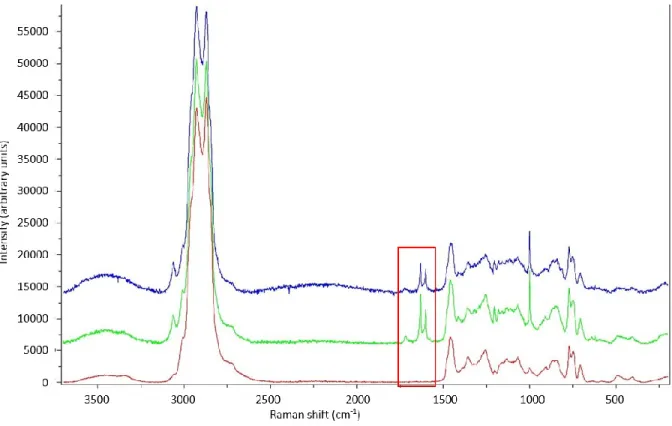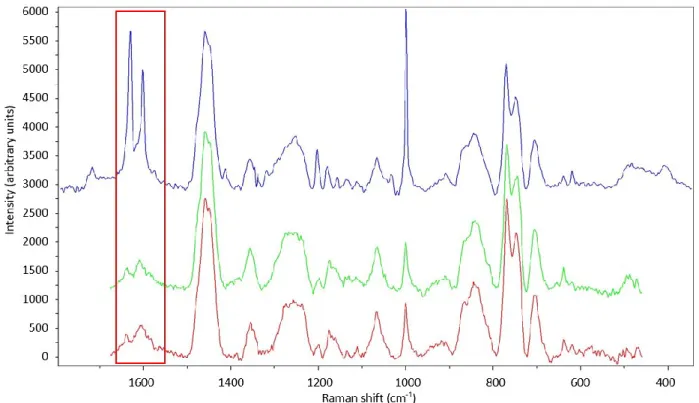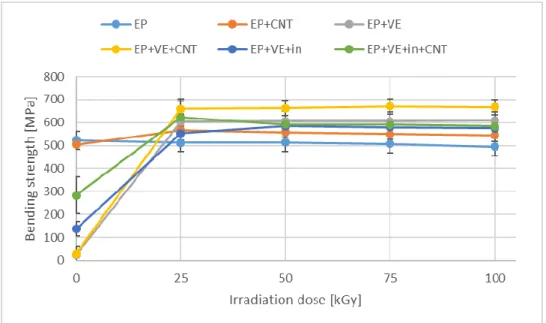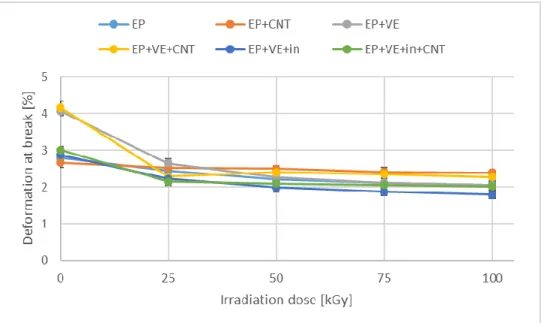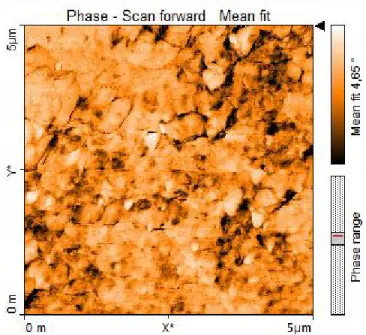This accepted author manuscript is copyrighted and published by Elsevier. It is posted here by agreement between Elsevier and MTA.
The definitive version of the text was subsequently published in Radiation Physics and Chemistry, 145, 2017, DOI:
10.1016/j.radphyschem.2017.12.018 Available under license CC-BY- NC-ND.
Interfacial adhesion improvement in carbon fiber/carbon nanotube reinforced hybrid composites by the application of a reactive hybrid resin initiated by gamma irradiation
G. Szebényi1,2*, D. Faragó1, Cs. Lámfalusi1, R. Göbl1
1 Department of Polymer Engineering, Faculty of Mechanical Engineering, Budapest University of Technology and Economics, Műegyetem rkp. 3., H-1111 Budapest, Hungary
2 MTA–BME Research Group for Composite Science and Technology, Műegyetem rkp. 3., H- 1111 Budapest, Hungary
* corresponding author: szebenyi@pt.bme.hu, +36-1-463-1466 E-mail addresses:
Gábor SZEBÉNYI – szebenyi@pt.bme.hu Dénes FARAGÓ – denes.farago@gmail.com Csaba LÁMFALUSI – csabalamfalusi@gmail.com Richárd GÖBL – richard.gobl@outlook.com
Abstract
Interfacial adhesion is a key factor in composite materials. The effective co-working of the reinforcing materials and matrix is essential for the proper load transfer between them, and to achieve the desired reinforcing effect. In case of nanocomposites, especially carbon nanotube
(CNT) reinforced nanocomposites the adhesion between the CNTs and the polymer matrix is poor.
To improve the interfacial adhesion and exploit the reinforcing effect of these nanoparticles a two step curable epoxy (EP)/vinylester (VE) hybrid resin system was developed where the EP is cured using hardener in the first step, during the composite production, and in the second step the curing of the VE is initiated by gamma irradiation, which also activates the reinforcing materials and the cured matrix component.
A total of six carbon fiber reinforced composite systems were compared with neat epoxy and EP/VE hybrid matrices with and without chemical initiator and MWCNT nano-reinforcement. The effect of gamma irradiation was investigated at four absorbed dose levels. According to our three point bending and interlaminar shear test results the adhesion has improved between all constituents of the composite system. It was demonstrated that gamma irradiation has beneficial effect on the static mechanical, especially interlaminar properties of both micro- and nanocomposites in terms of modulus, strength and interlaminar shear strength.
Keywords
polymer composite, interlaminar properties, gamma irradiation, radiation curing
1. Introduction
Carbon fiber (CF) reinforced polymer composites have been widely used as structural materials because of their unique merits such as low weight, high specific strength, high modulus and superior chemical resistance at elevated temperature. They are applied in various safety critical applications in the aerospace, transportation and renewable energetics sector (Holmes, 2017; Saba and Jawaid, 2017; Major and Karger-Kocsis, 2017; Maamar and Ramdane, 2016; Yuan et al., 2015; Ozdemir et al., 2016). The excellent properties of CF composites depend on the relationship
between CF and resin, interlaminar strength and toughness. In order to improve the overall adhesion between the fibers and the matrix, besides the conventional chemical sizing, various hybrid resins and various high energy irradiation techniques can be applied (Chen et al., 2017; Li et al., 2010; Xu et al., 2007; Diao et al., 2016; Sanes et al., 2016; Pino et al., 2007; Thomas et al., 1994).
After their discovery, carbon nanotubes (CNTs) became one of the most intensively investigated composite reinforcement material candidates (Kamae and Drzal, 2012; Sreekanth and Kanagaraj, 2015; Zhou et al., 2016; Thostenson et al., 2001; Jie et al., 2015; Guo et al., 2016). The interfacial adhesion between CNTs and the traditional resins is weak, to solve this issue application of hybrid resins combined with irradiation techniques can also bear high potential. This potential is investigated at several levels. Some researchers investigate the modification of nanoparticles with irradiation in neat format, before their introduction into the resin. It was already demonstrated that the surface properties of neat CNTs can be modified by different types of irradiation (Safibonab et al., 2011; Mølhave et al., 2007; Yang et al., 2010; Vishalli et al., 2017). The other level is the investigation of the effect of irradiation on the structure and properties of otherwise not linked hybrid resins and the nanoparticles, demonstrating that post-crosslinking can be initiated by different irradiations (Idesaki et al., 2014; Li et al., 2014; Nishimura et al., 2011; Xiancong et al., 2008; Szebényi et al., 2012). This post crosslinking procedure is demonstrated to improve the bending modulus of elasticity, the maximal bending stress, the interlaminar shear strength and to decrease the deformation at break of the treated composites (Sanes et al., 2016; Nishimura et al., 2011; Xiancong et al., 2008).
In this study, we investigated in detail the effects of four doses of gamma-ray irradiation on hybrid EP/VE resin matrix hybrid composites, where the VE component was demonstrated to stay reactive during the curing of the EP resin and its curing was initiated by gamma irradiation. Our research hypothesis was, that this two step technology facilitates the formation of bonds between both matrices and reinforcement materials, thereby improving the interfacial adhesion, and through this the mechanical properties of the prepared hybrid composites.
2. Materials and methods
Materials. For our research ER 1010 DGEBA (Bisphenol A diglycidyl ether) epoxy resin (Ipox Chemicals, Budapest, Hungary) was used with MH3124 curing agent (Ipox Chemicals, Budapest, Hungary) as matrix. The mixing weight ratio was 100:35 as recommended by the manufacturer.
For the hybrid matrices this epoxy was mixed with AME 6000 T35 (Ashland, Lexington, USA) vinylester resin which in some cases contained 1.5 weight percent Butanox M50 (Akzo Nobel, Amsterdam, Netherlands) initiator. The mixing weight ratio was 1:1.
Panex® 35 FBUD0300 (Zoltek, Nyergesújfalu, Hungary) unidirectional carbon fabric was used as micro sized reinforcement with a surface rate of 333g/m2.
Baytubes® C150 HP (Bayer, Leverkusen, Germany) multi walled carbon nanotubes were used as nano-sized reinforcement. The nanotubes were produced by catalytic CVD method, which resulted loose aggregates, no functionalization was performed. The nanotubes were 13-16 nm in outer mean diameter, above 1 μm in length, above 99% carbon purity content and free of amorphous carbon.
Mixing. Six types of matrices were used for preparing the laminates (Table 1). The MWCNTs were firstly mixed to the A component of the epoxy resin (in samples with only epoxy matrix) or to the vinylester resin (in vinylester containing samples) by three roll mixing at the Industrial Paint Research Ltd.(Budapest, Hungary) in 8 mass% content forming a well dispersed masterbatch. As
a second step the masterbatch was thinned back to the desired, 0.3 mass% final concentration compared to the mass of the matrix in the composite by neat resin.
No. Abbreviation Matrix Initiator Reinforcement
1 EP+CF epoxy - carbon fiber
2 EP/VE+CF epoxy/vinylester - carbon fiber
3 EP/VE+CF+in epoxy/vinylester + carbon fiber
4 EP+CF+NT epoxy - carbon fiber + 0.3 mass% MWCNT
5 EP/VE+CF+NT epoxy/vinylester - carbon fiber + 0.3 mass% MWCNT 6 EP/VE+CF+in+NT epoxy/vinylester + carbon fiber + 0.3 mass% MWCNT
Table 1. Summary of the prepared samples
The epoxy resin was mixed with the vinylester for 60 minutes using an RW 16 basic (IKA, Staufen, Germany) overhead stirrer equipped with a TR20 (Heidolph Instruments, Schwabach, Germany) radial flow impeller. The resins and the MWCNT masterbatch were premixed for 60 minutes.
Thereafter the curing agent and the initiator were mixed to the premixed or neat resin for 3 minutes.
Composite preparation. The composites were prepared by hand lamination followed by vacuum pressing at 0.5 bar vacuum for 2 hours. The laminates contained 6 layers of reinforcement in 0°
orientation. Six types of laminates were produced as shown in Table 1. Postcuring was performed in an UT 20 (Heraeus, Hanau, Germany) drying oven at 60°C for 4 hours. Gamma irradiation was performed at Agroster Co. Ltd. (Budapest, Hungary) using Co60 isotope. Specimens were irradiated by 25, 50, 75 and 100 kGy. The irradiation dose was verified by chlorobenzene dosimeters.
Characterization. The Raman spectra were recorded using a Horiba Jobin Yvon (Kyoto, Japan) LabRam Raman microscope with a 532 nm wavelength doubled-frequency Nd:YAG or a 785 nm wavelength diode LASER. Microscope objectives with 10x and 100x magnifications were used.
The photons originating from the Raman scatter were captured by a CCD sensor. The intensities of the Raman stripes were recorded as a function of Raman shift in arbitrary units correlating to
the detected photons. The measurement times were selected to stay below the saturation level of the detector (32000 counts). To achieve smoother spectra with the lower acquisition times multiple spectra were captured and averaged. Before each test run and LASER change the spectrometer was calibrated using a silicone single crystal sample. Baseline correction was performed on the spectra to exclude the effect of the fluorescent background radiation and to improve the comparability of the spectra.
The effect of gamma irradiation was characterized by three point bending and short span three point bending tests. The short span three point bending test were performed using an Instron (Norwood, USA) 8872 universal computer controlled loading frame, according to EN ISO 14130.
The support span was 15 mm and the test speed was 2 mm/min. The tests were performed at room temperature. The three point bending tests were performed using an Instron 8872 universal, computer controlled testing machine, according to EN ISO 178. The support span was 64 mm and the test speed was 5 mm/min. The tests were performed at room temperature.
The atomic force microscopic (AFM) tests were performed using a Nanosurf (Liestal, Switzerland) FlexAFM 5 AFM with silicone tip probes in non-contact and tapping operation. 5 μm x 5 μm areas were scanned with 5 μm/s scan speed and 500 row vertical resolution. To get information about the phase structure of the samples, besides the signal of the Z-modulation, characteristic to the topology, the vibration phase signal has also been recorded.
The scanning electron microscope (SEM) micrographs were taken by a JEOL JSM-6380LA (Tokyo, Japan) scanning electron microscope. The samples were gold spur coated with a JEOL FC-1200 device to achieve a thin conductive layer on their surface.
3. Results and discussion
One third of the specimens were not irradiated as a reference, the rest were irradiated by 25 and 50 kGy of gamma irradiation respectively. The reactivity of the VE component after the curing of the EP resin was checked by Raman spectrometry. The peak corresponding to the C=C stretching vibration at 1630 cm-1 Raman shift (Xiancong et al., 2008; Patacz et al., 2000), which was selected to track the progress of the curing, did not change in intensity during the composite production (Fig. 1.) and their intensity decreased drastically after the irradiation (Fig. 2.) showing that the curing was properly initiated by the applied irradiation doses.
Fig. 1. Raman spectra of the EP/VE matrix (neat EP, EP/VE before thermal postcuring, EP/VE after thermal postcuring from bottom to top)
Fig. 2. Raman spectra of the EP/VE matrix after gamma irradiation with different doses (0 kGy, 25 kGy, 50 kGy from top to bottom)
The result of the three point bending test can be seen in Figs. 3-5.
Fig. 3. Bending modulus of elasticity values obtained from the three point bending tests
Due to the irradiation up to 25 kGy absorbed dose the bending modulus of elasticity increased in all composites. Since photons in gamma radiation have high energy, they can create radicals on the oligomer chains by ripping off electrons from the atoms, creating highly reactive molecules.
However, this can also cause depolymerization by tearing down the carbon-carbon covalent bonds in the polymer chains. In case of the composites with neat epoxy as a matrix the increase was not significant. Also in case of the composite with traditionally cured hybrid matrix and CNTs the increase due to the irradiation was marginal. This shows that these systems are not sensitive to radiation, no significant increase in crosslink density and adhesion, no significant degradation can be observed. The reactive hybrid resin containing samples showed a different behavior. At 0 kGy irradiation, in their neat state their modulus of elasticity was significantly lower, but after 25 kGy irradiation dose a large increase could be observed. In this case the CNT containing composite outperformed all systems showing that probably due to the formation of bonds between the reinforcing materials and the matrices and the matrix phases. No significant change was observed at 50 kGy absorbed dose level, except in case of the standard hybrid composite, where the dominant effect was the further formation of bonds between the two matrix phases and the microsized reinforcement. The main difference in the behavior of the CNT containing and neat reactive hybrid matrix systems is that the CNTs can mediate the crosslinking of the VE resin so even a lower level of irradiation is sufficient to achieve the same stiffness of the matrix.
Fig. 4. Maximal bending stress values obtained from the three point bending tests
In case of maximal bending stress (Fig. 4.) a similar trend can be observed to the case of the bending modulus of elasticity (Fig. 3.). The increase in the maximal bending stress clearly shows that the CNTs could actively work as reinforcing materials, not only fillers. By the improved interfacial adhesion between them and the matrix the load transfer was improved so they could act as a reinforcement at nano-scale. This is exceptionally beneficial in case of the hybrid matrix where the molecules of the EP and VE form an interpenetrating network (IPN) structure where the phases alternate in a nanoscale pattern. A difference can be observed in the behavior of the traditionally cured CNT containing hybrid systems behavior. In this case it can be seen that the adhesion can not only improve when the VE is reactive, but also in the case of cured systems. In the maximal bending stress a lot of factors are present, like the resistance against crack propagation, delamination and fiber-matrix debonding. The improved adhesion and crosslink density can work against all these factors. The deformation at break (Fig. 5.) shows also valuable information about the fracture behavior.
Fig. 5. Deformation at break values obtained from the three point bending tests
On Fig. 5 it can be seen the composites with traditionally and gamma-ray initiated curing form clearly two groups. The composites cured with chemical additives had a moderate deformation at break, low ductility even without irradiation, while the composites containing uncured VE were tougher, could withstand a higher deformation at break. The effect of the addition of the CNTs is supports our previous assumptions showing differences with the increasing absorbed doses. While without irradiation the CNTs work as imperfections/fillers in the matrix, with the bonds created by the irradiation, they can integrate in the networked molecules, probably even connect the different polymers even in case of previously cured matrices.
Fig. 6. Interlaminar shear strength values obtained from the short span three point bending tests
According to the results of the interlaminar shear test (Fig. 6.) epoxy matrix composites have a much higher interlaminar shear strength while using traditional manufacturing methods since the vinylester fundamentally has lower strength and the sizing of the carbon fibers is mainly for epoxy resin. However by applying even only 25 kGy of gamma radiation the shear strength of the EP/VE hybrid matrix composites exceeds the value of those made by only EP. This can be caused by the improved adhesion between the reinforcing fibers/nanoparticles and the matrix by the formation of bonds between the reinforcing materials and matrix and even the sizing material on the surface of the fibers. Since one of the most common failure mode of composites is delamination due to shear load, this irradiation technic could be used to manufacture products with higher resistance than before.
The phase structure of the prepared composites was investigated by atomic force microscopy. A typical AFM micrograph of the composites is presented in Fig. 7. The micrograph shows that the phase structure of the EP/VE matrix is fine, the texture is below 500 nm, so nanoscale dispersion
of the two matrixes was achieved, which contributed to the good mechanical properties and supported the formation of bonds between the two phases.
Fig. 7. AFM phase micrograph of an EP/VE sample after 50 kGy gamma irradiation The fracture surfaces of the tested samples were investigated by SEM. Characteristic SEM micrographs of the neat and irradiated composites are presented in Fig. 8. The micrographs show clear difference in the morphology at the fiber matrix interface between the two composites. The micrographs show a much tougher interfacial fracture with matrix adhering to the fibers even after the complete fracture, better interfacial adhesion in case of the irradiation cured hybrid system.
Fig. 8. SEM micrographs of the broken EP (left) and EP/VE samples (right) after 50 kGy gamma irradiation
The mechanical test results correlate well with the data reported in the up-to-date literature. The results reported from the testing of neat VE systems cured by irradiation (Xiancong et al., 2008) show that the static mechanical properties of the resin itself is increasing with the irradiation dose up to 100 kGy irradiation dose. In our study the composites show a more complex, but also more fault tolerant structure, therefore the increase is more dramatic even at lower dose levels than in case of the neat resin. The irradiation not only improves the mechanical properties of the resin through the mediation of better crosslinking, but also the interaction of the fibers and the matrix and the two matrix components. The results of the interlaminar shear strength are also supported by the results achieved in case of neat VE matrix composites (Zsigmond et al., 2003) or even in case of PEI matrix composites, where the carbon fibers were irradiated before the composite production (Tiwari et al., 2011). In case of the pre-treated fibers a surface roughening phenomenon was reported caused by the irradiation. The better adhesion, demonstrated also by the SEM micrographs can be also partly caused by the activation of the fiber surface, which can be also achieved when the fibers are embedded in the matrix.
4. Conclusions
In our work we developed a novel EP/VE matrix CF/MWCNT reinforced composite system with significantly improved interfacial adhesion thanks to the gamma irradiation initiated curing of the VE part. A total of six composite systems were compared with neat epoxy and EP/VE hybrid matrices with and without chemical initiator and MWCNT nano-reinforcement. The effect of gamma irradiation was investigated at four absorbed dose levels. According to the test results it
was demonstrated that gamma irradiation has beneficial effect on the static mechanical, especially interlaminar properties of both micro- and nanocomposites in terms of modulus, strength and interlaminar shear strength. The gamma irradiation improved the co-working of the two phases of the IPN structure of the hybrid matrices, the reinforcing fibers and nanoparticles and the matrix.
By the application of the developed material and production technology, highly resistant hybrid nanocomposites can be manufactured by a high yield, automated production technology.
Acknowledgements
The authors would like to sincerely thank Miklós Bánréti and Agroster Co. Ltd. for the support, consultation and the gamma irradiation and Prof. Dr. Tibor Czvikovszky for his support and valuable comments. This research was supported by The National Research, Development and Innovation Office (NKFIH FK 124352, NKFIH K 116070 and NVKP_16-1-2016-0046). Gábor Szebényi acknowledges the financial support received through János Bolyai Scholarship of the Hungarian Academy of Sciences.
References
1. Chen, X., Xu, H., Liu, D., Yan, C., Zhu, Y., 2017. A facile one-pot fabrication of polyphosphazene microsphere/carbon fiber hybrid reinforcement and its effect on the interfacial adhesion of epoxy composites. Applied Surface Science 410, 530-539.
2. Diao, F., Zhang, Y., Liu, Y., Fang, J., Luan, W., 2016. γ-Ray irradiation stability and damage mechanism of glycidyl amine epoxy resin. Nuclear Instruments and Methods in Physics Research Section B: Beam Interactions with Materials and Atoms 383, 227-233.
3. Guo, J., Zhang, Q., Cai, Z., Zhao, K., 2016. Preparation and dye filtration property of electrospun polyhydroxybutyrate–calcium alginate/carbon nanotubes composite nanofibrous filtration membrane. Separation and Purification Technology 161, 69-79.
4. Holmes, M., 2017. Aerospace looks to composites for solutions. Reinforced Plastics.
5. Idesaki, A., Uechi, H., Hakura, Y., Kishi, H., 2014. Effects of gamma-ray irradiation on a cyanate ester/epoxy resin. Radiation Physics and Chemistry 98, 1-6.
6. Jie, G., Kongyin, Z., Xinxin, Z., Zhijiang, C., Min, C., Tian, C., Junfu, W., 2015.
Preparation and characterization of carboxyl multi-walled carbon nanotubes/calcium alginate composite hydrogel nano-filtration membrane. Materials Letters 157, 112-115.
7. Kamae, T., Drzal, L.T., 2012. Carbon fiber/epoxy composite property enhancement through incorporation of carbon nanotubes at the fiber–matrix interphase – Part I: The development of carbon nanotube coated carbon fibers and the evaluation of their adhesion.
Composites Part A: Applied Science and Manufacturing 43, 1569-1577.
8. Li, J.-Q., Huang, Y.-D., Fu, S.-Y., Yang, L.-H., Qu, H.-t., Wu, G.-s., 2010. Study on the surface performance of carbon fibres irradiated by γ-ray under different irradiation dose.
Applied Surface Science 256, 2000-2004.
9. Li, J., Wu, Z., Huang, C., Li, L., 2014. Gamma irradiation effects on cyanate ester/epoxy insulation materials for superconducting magnets. Fusion Engineering and Design 89, 3112-3116.
10. Maamar, D.B., Ramdane, Z., 2016. Characterization of the Mechanical Behaviour of Carbon Fiber Composite Laminate under Low Velocity Impact. Periodica Polytechnica Mechanical Engineering 60, 142-151.
11. Major, Z., Karger-Kocsis, J., 2017. Advanced composites when imaginengineering meets reality. Expresss Polymer Letters 11, 83.
12. Mølhave, K., Gudnason, S.B., Pedersen, A.T., Clausen, C.H., Horsewell, A., Bøggild, P., 2007. Electron irradiation-induced destruction of carbon nanotubes in electron microscopes. Ultramicroscopy 108, 52-57.
13. Nishimura, A., Izumi, Y., Imaizumi, M., Nishijima, S., Hemmi, T., Shikama, T., 2011.
Neutron and gamma ray irradiation effects on interlaminar shear strength of insulation materials with cyanate ester–epoxy blended resin. Fusion Engineering and Design 86, 1558-1561.
14. Ozdemir, N.G., Zhang, T., Aspin, I., Scarpa, F., Hadavinia, H., Song, Y., 2016. Toughening of carbon fibre reinforced polymer composites with rubber nanoparticles for advanced industrial applications. Express Polymer Letters 10, 394-407.
15. Patacz, C., Defoort, B., Coqueret, X., 2000. Electron-beam initiated polymerization of acrylate compositions 1 : FTIR monitoring of incremental irradiation. Radiation Physics and Chemistry 59, 329-337.
16. Pino, E.S., Machado, L.D.B., Giovedi, C., 2007. Improvement of carbon fiber surface properties using electron beam irradiation. Nuclear Science and Techniques 18, 39-41.
17. Saba, N., Jawaid, M., 2017. 3 - Epoxy resin based hybrid polymer composites, Hybrid Polymer Composite Materials. Woodhead Publishing, pp. 57-82.
18. Safibonab, B., Reyhani, A., Nozad Golikand, A., Mortazavi, S.Z., Mirershadi, S., Ghoranneviss, M., 2011. Improving the surface properties of multi-walled carbon nanotubes after irradiation with gamma rays. Applied Surface Science 258, 766-773.
19. Sanes, J., Saurín, N., Carrión, F.J., Ojados, G., Bermúdez, M.D., 2016. Synergy between single-walled carbon nanotubes and ionic liquid in epoxy resin nanocomposites.
Composites Part B: Engineering 105, 149-159.
20. Sreekanth, P.S.R., Kanagaraj, S., 2015. Influence of multi walled carbon nanotubes reinforcement and gamma irradiation on the wear behaviour of UHMWPE. Wear 334, 82- 90.
21. Szebényi, G., Romhány, G., Vajna, B., Czvikovszky, T., 2012. EB treatment of carbon nanotube-reinforced polymer composites. Radiation Physics and Chemistry 81, 1383- 1388.
22. Thomas, Y., Parisi, J.P., Boutevin, B., Beziers, D., Chataignier, E., Désarmot, G., 1994.
Improvement of fibre/matrix bonding in carbon-fibre/acrylic composites by electron- irradiation: Concept of difunctional chemical coupling agent. Composites Science and Technology 52, 299-307.
23. Thostenson, E.T., Ren, Z., Chou, T.-W., 2001. Advances in the science and technology of carbon nanotubes and their composites: a review. Composites Science and Technology 61, 1899-1912.
24. Tiwari, S., Bijwe, J., Panier, S., 2011. Gamma radiation treatment of carbon fabric to improve the fiber–matrix adhesion and tribo-performance of composites. Wear 271, 2184- 2192.
25. Vishalli, Avasthi, D.K., Srivastava, A., Dharamvir, K., 2017. Transformation of multi walled carbon nanotubes irradiated by swift heavy ions. Nuclear Instruments and Methods in Physics Research Section B: Beam Interactions with Materials and Atoms 407, 172-179.
26. Xiancong, H., Meiwu, S., Guotai, Z., Hong, Z., Xiaopeng, H., Chunlan, Z., 2008.
Investigation on the electron-beam curing of vinylester resin. Radiation Physics and Chemistry 77, 643-655.
27. Xu, Z., Huang, Y., Zhang, C., Liu, L., Zhang, Y., Wang, L., 2007. Effect of γ-ray irradiation grafting on the carbon fibers and interfacial adhesion of epoxy composites. Composites Science and Technology 67, 3261-3270.
28. Yang, D.-S., Jung, D.-J., Choi, S.-H., 2010. One-step functionalization of multi-walled carbon nanotubes by radiation-induced graft polymerization and their application as enzyme-free biosensors. Radiation Physics and Chemistry 79, 434-440.
29. Yuan, J., Na, C., Xu, Y., Zhao, C., 2015. Wind turbine manufacturing in China: A review.
Renewable and Sustainable Energy Reviews 51, 1235-1244.
30. Zhou, H.W., Mishnaevsky, L., Yi, H.Y., Liu, Y.Q., Hu, X., Warrier, A., Dai, G.M., 2016.
Carbon fiber/carbon nanotube reinforced hierarchical composites: Effect of CNT distribution on shearing strength. Composites Part B: Engineering 88, 201-211.
31. Zsigmond, B., Halász, L., Czvikovszky, T., 2003. Electron beam processing of carbon fibre reinforced braided composites. Radiation Physics and Chemistry 67, 441-445.

